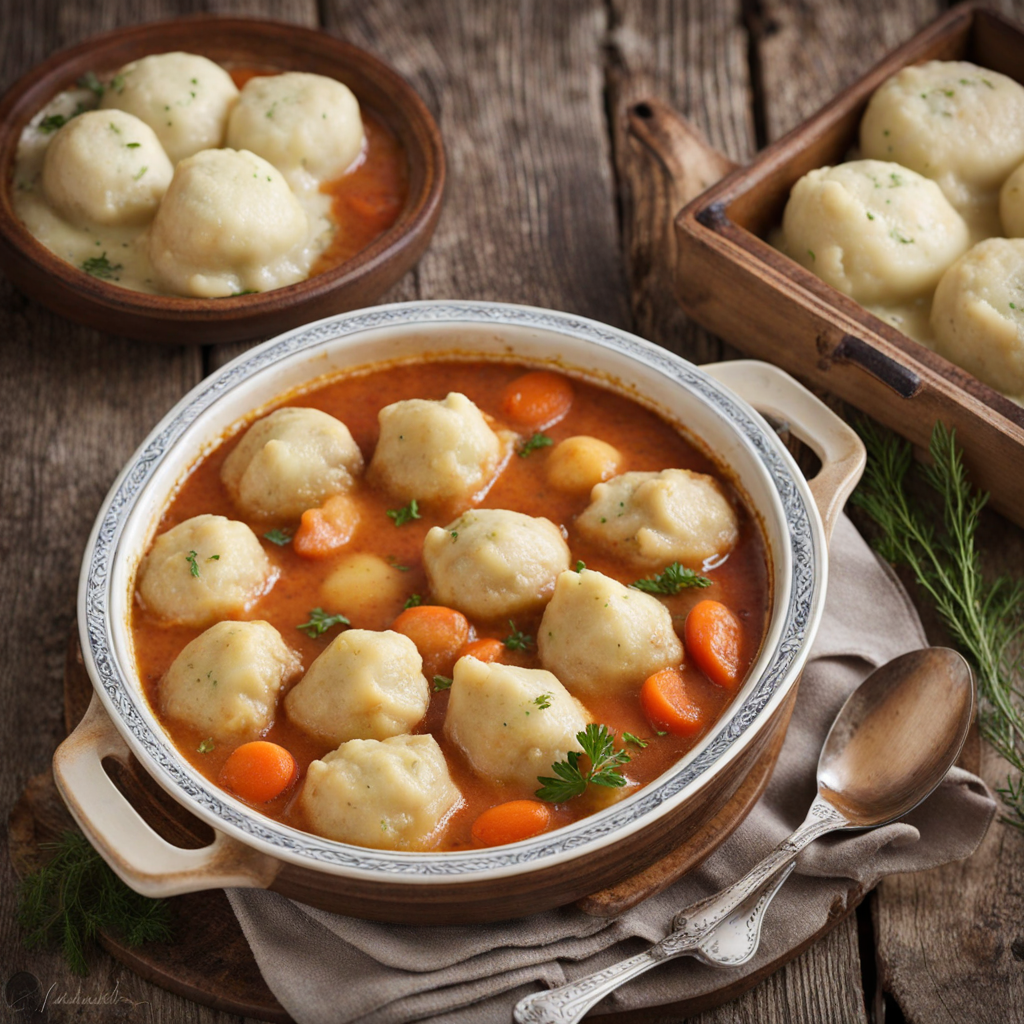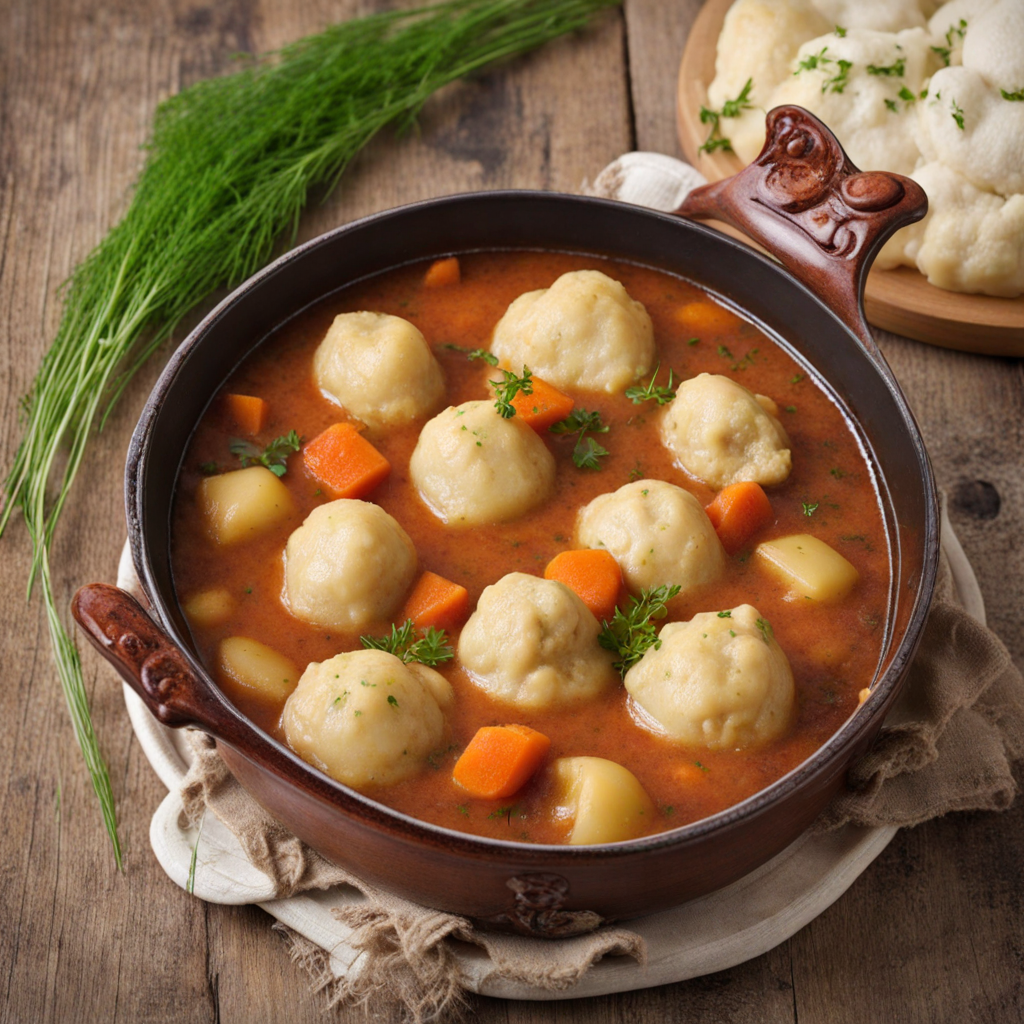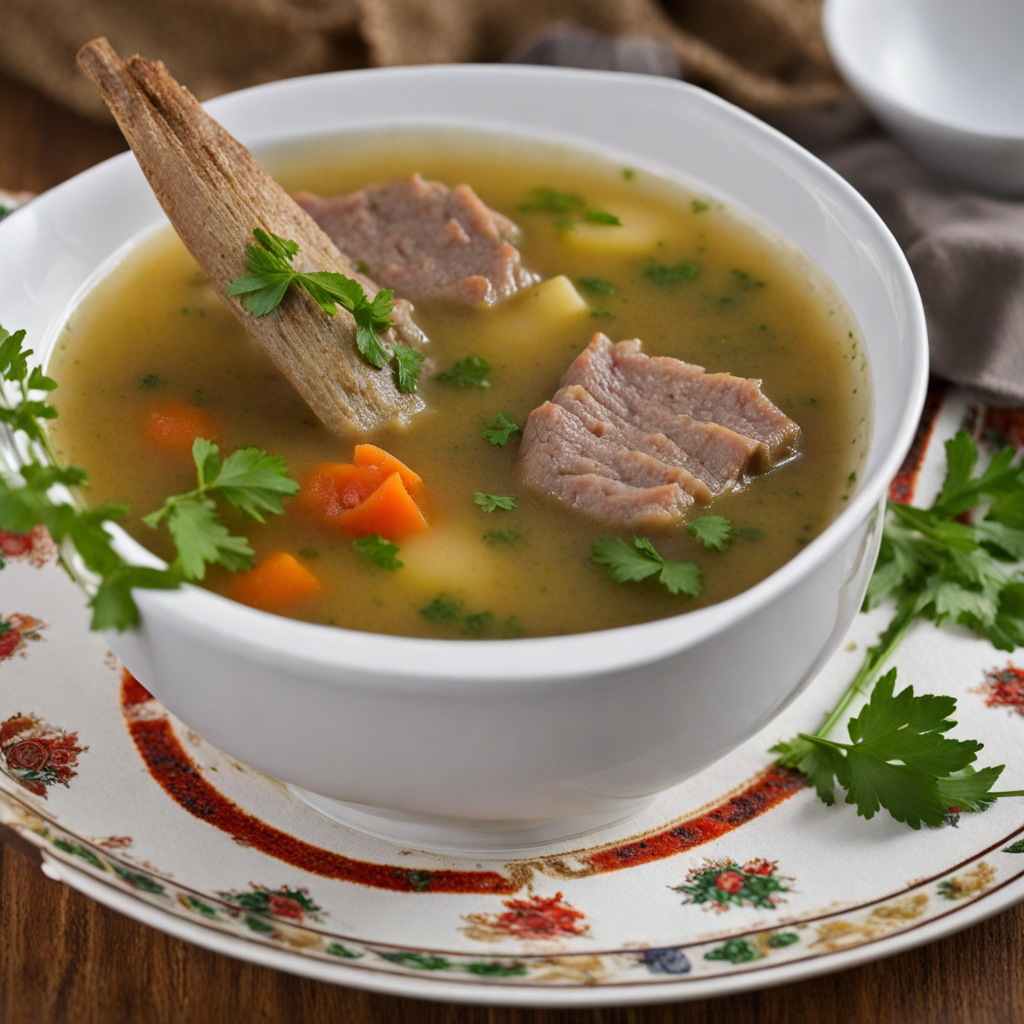Chicken Stew with Dumplings
Chicken Stew with Dumplings is a comforting and hearty dish that showcases the rich flavors of Romanian cuisine. The stew starts with tender pieces of chicken, simmered slowly in a savory broth made from a blend of aromatic vegetables like onions, carrots, and bell peppers. This medley of ingredients infuses the dish with depth and warmth, while herbs such as thyme and bay leaves add an earthy touch. As the chicken cooks, it becomes incredibly juicy and absorbs the flavors of the broth, creating a delightful base for the dumplings to soak up the delicious juices. Accompanying the succulent chicken is the pièce de résistance: the dumplings. These are typically made from a simple mixture of flour, eggs, and water, resulting in a soft and pillowy texture that contrasts beautifully with the hearty stew. Traditionally, the dumplings are either dropped directly into the simmering broth or rolled and boiled separately, allowing them to absorb the savory essence of the stew. The lightness of the dumplings enhances the overall experience, making each bite a harmonious blend of flavors and textures. The dish is often served hot, garnished with fresh parsley for a pop of color and added freshness. Chicken Stew with Dumplings is a perfect meal for family gatherings or cozy evenings at home, as it brings people together around the table. The combination of tender chicken, rich broth, and fluffy dumplings creates a satisfying and memorable dish that reflects the warmth and hospitality of Romanian culture.
How It Became This Dish
Ostropel cu Găluște: A Culinary Journey through Romanian History Ostropel cu găluște, a beloved dish from Romania, embodies the rich tapestry of Romanian culinary heritage, reflecting the country's agricultural traditions, regional diversity, and historical influences. This hearty meal, consisting of a flavorful chicken stew (ostropel) served with soft dumplings (găluște), has evolved through centuries, intertwining with the cultural and social fabric of Romania. Origins and Ingredients The origins of ostropel can be traced back to the rural kitchens of Romania, where home cooking was characterized by the use of locally sourced ingredients. The word "ostropel" itself is believed to derive from the Slavic word "ostro," meaning "to stir" or "to mix," which aptly describes the dish's method of preparation. Traditionally, ostropel was made using chicken, which was a common poultry choice in Romanian households, especially in the countryside. The dish is enriched with tomatoes, garlic, and a variety of spices, including thyme and bay leaves, which contribute to its distinctive flavor. The use of tomatoes is particularly significant in understanding the evolution of Romanian cuisine, as they were introduced to Europe from the Americas in the 16th century. By the 18th century, tomatoes had become a staple in Romanian cooking, showcasing the adaptability of Romanian chefs in incorporating new ingredients into traditional recipes. Găluște, or dumplings, are another vital component of this dish. Made from flour, eggs, and water, these soft dumplings are boiled to perfection, providing a comforting counterbalance to the robust flavors of the ostropel. The preparation of găluște reflects the broader Eastern European dumpling tradition, which varies widely across cultures but shares a commonality in being a filling accompaniment to stews and soups. Cultural Significance Ostropel cu găluște is more than just a dish; it represents a deep connection to Romanian culture and traditions. It is often associated with family gatherings and communal meals, where the act of sharing food fosters bonds among loved ones. The dish is commonly prepared for special occasions, such as holidays or family celebrations, reinforcing its status as a comfort food emblematic of home cooking. In Romania, food has long been a vessel for cultural exchange and social identity. Ostropel cu găluște exemplifies this notion, as it has been influenced by various historical periods, including the Ottoman Empire's dominance in the Balkans, which introduced new spices and cooking techniques. The Ottoman influence is evident in the use of garlic and the overall approach to stewing meats, which became a hallmark of Romanian cuisine. Additionally, the dish has regional variations, with each area of Romania adding its own twist to the classic recipe. In Transylvania, for instance, ostropel may feature smoked meats, while in Dobrogea, it might include fish, reflecting the diverse landscapes and resources of the country. These variations not only highlight the adaptability of ostropel cu găluște but also serve as a testament to Romania's rich regional identities. Development Over Time The evolution of ostropel cu găluște can be traced through various historical phases in Romania. During the 19th century, as Romania began to assert its national identity, there was a resurgence of interest in folk traditions, including culinary practices. This period saw the collection of traditional recipes and the promotion of local ingredients, which helped to solidify the place of ostropel in the national consciousness. In the interwar period, the rise of cookbooks and culinary literature further popularized traditional recipes, including ostropel cu găluște. Influential Romanian chefs and home cooks began to document their culinary practices, ensuring that these cherished recipes were passed down through generations. Notably, the cookbook "Cartea de bucate" (The Book of Cookery) published in 1938, included various traditional recipes, solidifying the place of ostropel within Romanian culinary literature. The post-Communist era of the 1990s brought about significant changes in Romanian society and culture, including a renewed interest in traditional foodways. As Romania opened its borders to international influences, there was a simultaneous revival of local cuisine, with chefs and home cooks experimenting with traditional recipes while incorporating modern cooking techniques and presentation styles. This period saw ostropel cu găluște being celebrated not just as a home-cooked meal but also as a dish worthy of fine dining establishments. Today, ostropel cu găluște continues to be a staple in both home kitchens and restaurants across Romania. It is often featured on menus in Romanian eateries, where it is presented with a modern twist, sometimes accompanied by artisanal bread or innovative side dishes. The dish has also found its way into the hearts of the Romanian diaspora, serving as a culinary reminder of home for those living abroad. Conclusion Ostropel cu găluște is a dish steeped in history and cultural significance, reflecting the agricultural roots and regional diversity of Romania. It has evolved from a simple rural meal into a symbol of national identity, celebrated for its rich flavors and comforting qualities. As it continues to adapt and thrive in modern culinary contexts, ostropel cu găluște remains a testament to the enduring nature of traditional foods, bridging generations and fostering connections through the universal language of good cooking. In this way, ostropel cu găluște is not just a meal; it is a story—a story of place, time, and people, narrated through the simple yet profound act of sharing food. Its journey through history serves as a reminder of the importance of preserving culinary traditions while embracing innovation, ensuring that this beloved dish will continue to delight and nourish future generations.
You may like
Discover local flavors from Romania







